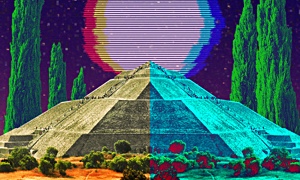
In 1989, blues singer/guitarist John Lee Hooker exploded, again, onto the music scene with an extraordinary recording. The Healer, which might have easily been a denouement in a luminous career, served as a new beginning, marked with a Grammy award for “I'm in the Mood," a re-sculptured duet with singer/slide guitarist Bonnie Raitt. While the record was well received for its all star cast, including Raitt, Carlos Santana, Keith Richards and Canned Heat, critics accused the bluesman of spreading himself too thin with uneven music ranging from blues to Latin forms. In any case, The Healer retains the distinction of being a golden catapult to a rejuvenated career that would end as it had begun: peerless.
Hooker was born in a sharecropper's shack on April 17, 1917, in Clarksdale, Mississippi. One of eleven brothers and sisters, he learned to appreciate and play the blues through the influence of his stepfather. Hooker has said of those days, “My stepdaddy--I used to sit down and listen to him--he would do a tune called the boogie woogie. And I said, 'Some day I'm gonna get famous and put that on record, and the world gonna know who did the boogie.'"
As a teenager, Hooker sought ingress into the Memphis music scene with his country boogies, but found better luck in Cincinnati. In 1943, after seven years in Ohio, Hooker relocated to Detroit where he found steady work both making music and as a steelworker. It was in 1948 that Hooker cut his first sides, “Boogie Chillen" and “Sally Mae," for Bernie Besman's Sensation label.
Hooker's music came as an immediate and welcome surprise to those only familiar with the impassioned sounds of Delta and country blues. With the single “Boogie Chillen," Hooker introduced the world to his family's boogie. The song was raw and dark, a cultivation of the sounds he had assimilated in the cities and his own one-chord boogie style. In an interview with music historian Greg Drust, Hooker reminisced, “When I did 'Boogie Chillen,' it just broke out. I hollered 'Boogie Chillen' and that was a hit for about one year straight alone."
When I first came to town people, I was walkin' down Hazen Street. I heard everybody talkin' about the Henry Swing Club. I decided to stop in there that night, and when I got there I say, “Yes, people" Yes, they was really havin' a ball! Yes, I know. Boogie chillen!Hooker was soon able to quit his day gigs for full time employment as a musician. He recorded for many labels in the 1950's and 1960's, including Modern, King, Crown, Chess, Galaxy, Riverside, and Vee-Jay. His biggest hit came in 1962 with the Vee-Jay release of “Boom Boom," an irresistible R&B/blues that was to be relentlessly and reverently covered by rock and rollers on both sides of the Atlantic. Everyone from the Rolling Stones to Eric Burdon adored Hooker and his deceptively smart music. In 1970, Hooker joined American blues band Canned Heat on Hooker 'n' Heat to reciprocate the affection, lay down some inspired jams, and sell copious amounts of records.
Hooker's discography from the 1970's and 1980's is interesting with some serious gems on the MCA and Tomato labels. But his popularity and that of the blues in general faded with the introduction of new music trends such as fusion and disco. Far from lapsing quietly into obscurity, however, Hooker kept busy on the fringes of popular music. He achieved a small boost in notoriety through a memorable cameo during this period as a Chicago street performer in The Blues Brothers film.
But it wasn't until he collaborated with slide guitarist Roy Rogers in 1989 that Hooker would reenter the limelight of blues recording and performing. The Healer was released, the first of many discs that would feature guest appearances with performers from of all areas of music. The following years were busy and reaped huge financial success. His popularity surged with Pepsi commercials, tours, and even the opening of his own bar in 1997, San Francisco's “Boom Boom Room." In addition to receiving four Grammies in the 1990's, Hooker was inducted into the Rock and Roll Hall of Fame.
In the liner notes to Rhino's John Lee Hooker: The Ultimate Collection 1948-1990, Hooker said, looking back upon his early days of performing, “I wish those days was here again. I really enjoyed just sitting down with my guitar, playing soft, slow blues, quiet, not loud, talking to the people, and they were just right around me in those coffeehouses
For more information contact All About Jazz.






















